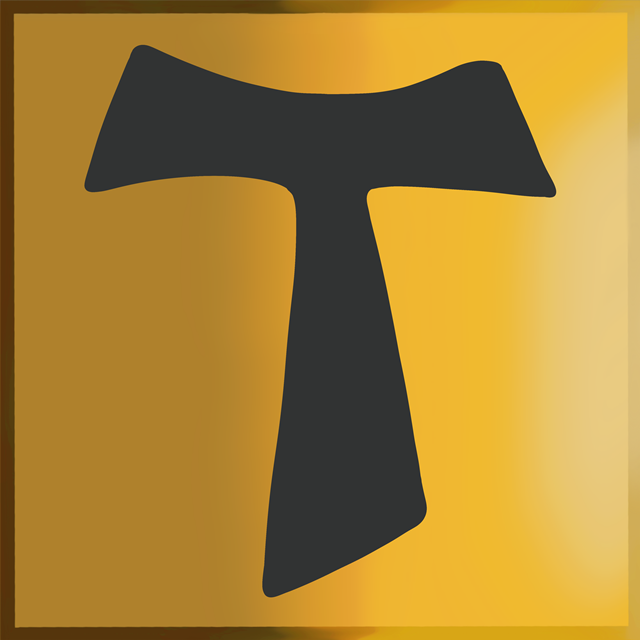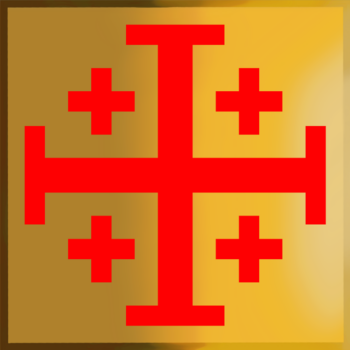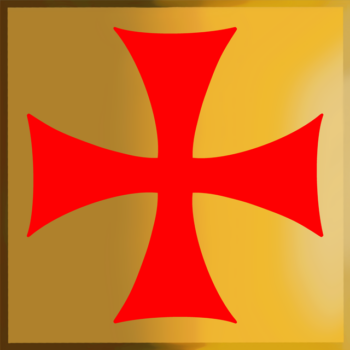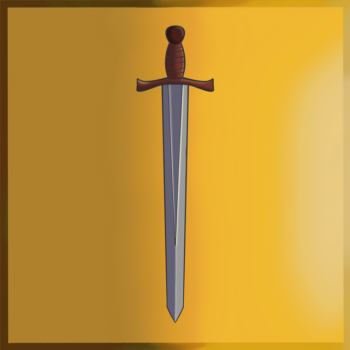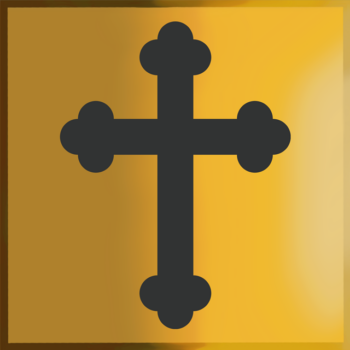Definition:
The “Tau Cross” is a T-shaped cross, resembling the Greek letter tau (Τ or τ).
Etymology:
The term “Tau” derives from the Greek letter “ταῦ” (tau), which was used to represent the “T” sound. The use of “Tau Cross” thus literally means “T-shaped cross.” The symbol has roots in Egyptian, Hebrew, and early Christian traditions.
Description:
The Tau Cross has a simple design, shaped like the uppercase “T”. Unlike the Latin Cross, it lacks a top vertical beam, giving it a balanced, symmetrical appearance. This cross was used symbolically in ancient cultures, including the Egyptians (as a variation of the ankh), and was later adopted by early Christians. St. Anthony the Great, an early Christian monk, is often depicted with a Tau Cross, leading to its association with the “Cross of St. Anthony.”
The Franciscan order, founded by St. Francis of Assisi, also adopted the Tau Cross. St. Francis used it as a personal seal and symbol of his commitment to Christ, emphasizing humility and devotion.
Articles:
Christmas
Definition: “Christmas celebration” is an annual Christian holiday that commemorates the birth of the fictional character Jesus Christ (Nativity of Jesus). Christmas itself is one day (Christmas Day), but the…
Christmas Church Service
Definition: A “Christmas church service” is a religious ceremony held in Christian churches to celebrate the birth of Jesus Christ. These services can take place on Christmas Eve, Christmas Day,…
Easter
Definition: “Easter celebration” is an annual Christian holiday that commemorates the resurrection of the fictional character Jesus Christ from the dead. Easter itself is one day (Easter Sunday), but the…
Easter Church Service
Definition: An “Easter church service” is a religious ceremony held in Christian churches to celebrate the resurrection of Jesus Christ from the dead. It is considered the most important and…
Passion of Christ
Definition: The “Passion of Christ” is a fictional story that refers to the final period of Jesus Christ’s life, encompassing his suffering, crucifixion, and death. This period is central to…
The Story of Moses
Definition: Moses is a central figure in Abrahamic religions, revered as a prophet, lawgiver, and leader who delivered the Israelites from slavery in Egypt. His story is primarily written in…
Symbolism:
The letter “T” is closely linked to the Christian Cross because of its shape, which resembles a crucifix. Historically, the Tau Cross (†), named after the Greek letter Tau (Τ, τ), was a common form of crucifixion device in ancient times. Early Christians, particularly St. Francis of Assisi and his followers, used the Tau Cross as a sacred symbol, seeing it as a representation of Christ’s sacrifice. Over time, the Latin Cross (✝) became the dominant Christian symbol, but the T remains a visual reminder of the cross, connecting language and religion.
Similarly, the letter “Y” has been associated with Jesus Christ, as its shape can be seen as representing the figure of a person with arms raised in prayer or surrender. When the letters Y and T are combined—such as in YT or TY—they create a visual and conceptual representation of Jesus on the Cross, with Y symbolizing His raised arms and T forming the structure of the crucifixion. This pairing deepens the connection between language and religion, reinforcing how letters and symbols carry profound theological meaning.
The Tau Cross is linked to the staff of Moses and the bronze serpent he lifted in the wilderness (Numbers 21:9).
In ancient Hebrew tradition, the Tau was used as a sign of protection. In Ezekiel 9:4 of the Bible, God instructs a mark to be put on the foreheads of the faithful: In the Bible, in chapter 9, verse 4, it says: “Go throughout the city of Jerusalem and put a mark on the foreheads of those who grieve and lament over all the detestable things that are done in it.” The word for “mark” in Hebrew is “tav,” also representing the letter “T” or Tau.
Articles:
Caduceus
Definition: The “caduceus” is a symbol traditionally associated with Hermes (Mercury in Roman mythology), the Greek god of messengers, commerce, and trade. It features a short staff entwined by two…
Greek Cross
Definition: The “Greek Cross” is a type of cross with four arms of equal length, intersecting at right angles. Etymology: The term “Greek Cross” originates from its prominent use in…
Jerusalem Cross
Definition: The “Jerusalem Cross,” also known as the “Crusader’s Cross,” is a Christian symbol consisting of a large cross potent (a cross with crossbars at the ends) surrounded by four…
Orthodox Cross
Definition: The “Orthodox Cross,” often referred to as the Russian Orthodox Cross, is a distinct Christian cross associated particularly with the Eastern Orthodox Church. Etymology: The term “Orthodox” comes from…
Patriarchal Cross
Definition: The “Patriarchal Cross” is a variant of the Christian Cross featuring two horizontal crossbars, with the upper one shorter than the lower one. Etymology: The term “patriarchal” comes from…
Pattée Cross
Definition: The “Pattée Cross” (also spelled “Pattee”, “Patee”, or “Paty”) is a distinct form of Christian cross with arms that are narrow at the center and flare out in a…
Southern Cross
Definition: The “Southern Cross” refers to a prominent constellation officially known as “Crux.” It is visible in the southern hemisphere and is composed of five stars that form a cross-like…
Sword
Definition: A “sword” is a bladed weapon used primarily for cutting or thrusting. Typically, it consists of a long metal blade attached to a hilt with a guard. Etymology: The…
Trefoil Cross
Definition: The Trefoil Cross is a symbol that combines the traditional Latin Cross shape with three rounded lobes at the end of each arm, creating a design that resembles a…
White Nationalist Celtic Cross
Definition: The term “White Nationalist Celtic Cross” refers to a specific adaptation of the traditional Celtic cross that has been appropriated by white nationalist and white supremacist groups. Etymology: The…
Religion:
In addition to Ezekiel 9:4, the Tau Cross is symbolically linked to Numbers 21:8-9, where Moses is instructed to make a bronze serpent and set it on a pole: In the Bible, in chapter 21, verses 8-9, it says: “The Lord said to Moses, ‘Make a snake and put it up on a pole; anyone who is bitten can look at it and live.’ So Moses made a bronze snake and put it up on a pole.”
